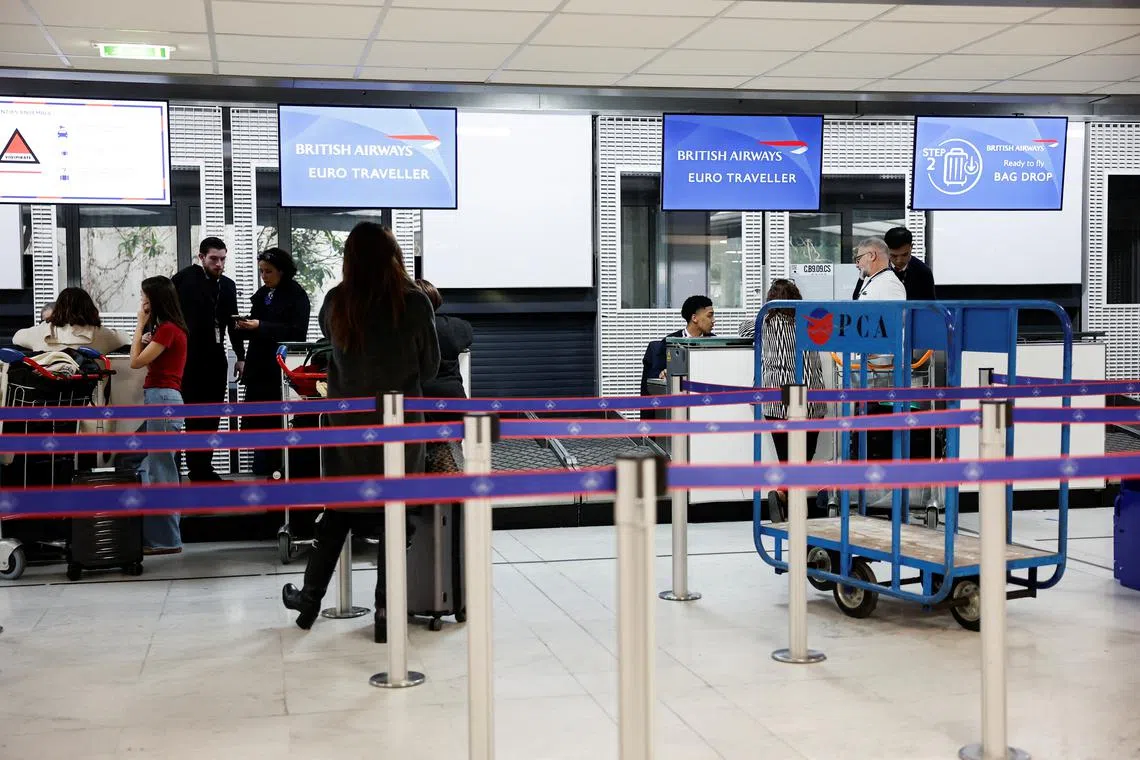Heathrow Airport reopens after shutdown, travellers face days of disruption
Sign up now: Get ST's newsletters delivered to your inbox

Teams were working across the airport to support passengers affected by the outage, a Heathrow spokesperson said.
PHOTO: REUTERS
Follow topic:
LONDON - London’s Heathrow Airport resumed full operations on March 22, a day after a fire knocked out its power supply and shut Europe’s busiest air hub, but airlines warned of delays and cancellations as schedules are fixed and affected passengers are rerouted.
British Airways, whose main hub is Heathrow, said it expected around 85 per cent of its schedule to proceed on March 22, and chief executive Sean Doyle warned of a “huge impact on all of our customers flying with us over the coming days”.
The airport, the world’s fifth-busiest, had been due to handle 1,351 flights on March 21, flying up to 291,000 passengers. But the fire at a nearby electrical substation
Britain’s energy ministry said on March 22 it had commissioned the National Energy System Operator to carry out an urgent investigation into the outage that raised questions about the resilience of the country’s critical infrastructure.
Heathrow said it had tasked an independent board member, former transport minister Ruth Kelly, with undertaking a review of the airport’s crisis-management plan and its response to the incident with the aim of boosting resilience.
Aviation experts said the last time European airports experienced disruption on such a large scale was the 2010 Icelandic volcanic ash cloud that grounded some 100,000 flights.
“It has been absolutely insane”, said Ms Amber Roden, a US citizen getting married in three days’ time, after a number of her relatives had their flights cancelled.
Two relatives who were halfway to London from Atlanta had to turn around and go back, she said. Two others will not make it to the UK until the day of the wedding, which she has been planning for two years.
The vast majority of scheduled morning and early afternoon flights departed successfully on March 22, with a handful of delays and cancellations, Heathrow’s departures website showed.
“We don’t expect any major amount of flights to be cancelled or delayed,” Heathrow chief executive Thomas Woldbye told BBC radio.
The airport has hundreds of additional staff on hand to facilitate an extra 10,000 passengers travelling through the airport, a spokesperson said in a statement.
But airlines were still left dealing with disrupted schedules and the tens of thousands of passengers whose journeys had been interrupted.
Virgin Atlantic said on March 22 that it was planning to run a near-full schedule with limited cancellations. Air India said it had restarted flights to and from Heathrow and expected to operate “as per schedule”.
Fire not suspicious
Several passengers travelling to Heathrow from London’s Paddington Station were still nervous.
“I’m just hoping that when I get there, I can actually go,” said university professor Melissa Graboyes, who said she was repeatedly checking the status of her flight to Toronto.
Police said that after an initial assessment they were not treating the incident as suspicious, although inquiries remained ongoing. London Fire Brigade said its investigations would focus on the electrical distribution equipment.
The travel industry, facing the prospect of a financial hit costing tens of millions of pounds and a likely fight over who should pay, questioned how such crucial infrastructure could fail without backup.
“It is a clear planning failure by the airport,” said Mr Willie Walsh, head of global airlines body IATA, who, as former head of British Airways, has for years been a fierce critic of the crowded hub.
Heathrow and London’s other major airports have been hit by other outages in recent years, most recently by an automated gate failure and an air traffic system meltdown, both in 2023.
“Britain humiliated by airport fiasco,” read a headline in the Sun newspaper.
“Farcical”, wrote the Daily Mail. REUTERS

